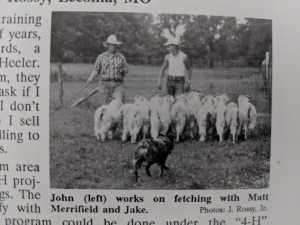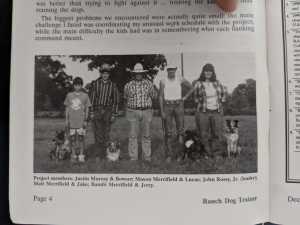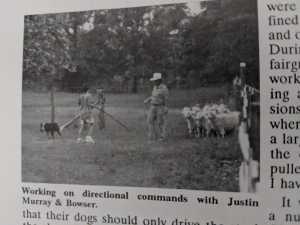Reprinted with Permission from Stockdog Trainer, Dec 90/Jan 91
by John C. Rossy, Lecoma MO
 I’ve been raising sheep and training my own dogs for a number of years, including Australian Shepherds, a Border Collie, and a Blue Heeler. When people come to my farm, they will see my dogs at work and ask if I raise and train working dogs. I don’t train dogs for people, nor do I sell trained dogs; but I’m always willing to help them train their own dogs.
I’ve been raising sheep and training my own dogs for a number of years, including Australian Shepherds, a Border Collie, and a Blue Heeler. When people come to my farm, they will see my dogs at work and ask if I raise and train working dogs. I don’t train dogs for people, nor do I sell trained dogs; but I’m always willing to help them train their own dogs.
After a number of calls from area people, I decided to start a 4-H project to help kids with their dogs. The 4-H association had to verify with their headquarters that the program could be done under the “4-H” designation — and the leadership felt that it was a good idea.
Since this type of project had never been done in our area, I first had to set some ground rules: the children had to take a 4-H Basic Dog Obedience class; the minimum age of the dog had to be one year; the child had to be at least ten years old; and the dog had to be of a herding breed. I also encouraged parent participation – in fact, some parents brought along dogs as well. As it turned out, the children and adults who participated were from farms and ranches that all had a need for a well-trained working dog. The breeds in attendance were Border Collies, Blue Heelers, Australian Shepherds, and one Border Collie/Blue Heeler cross.
 My goals for this six-week class were to work on the basics of fetching, and teaching directions and commands. The sessions lasted approximately two hours each, a total of about twelve hours.
My goals for this six-week class were to work on the basics of fetching, and teaching directions and commands. The sessions lasted approximately two hours each, a total of about twelve hours.
At our first session, I did an instinct test on the dogs. Using the Dent County Fairgrounds in Salem, Missouri, I brought Angora goats in a stock trailer. As an approved Instinct Tester for the American Herding breeds Association, I more or less followed that group’s guidelines. Th Angoras were released in an enclosed area, and one dog was released with them. Even though all the dogs were from herding breeds, I had felt uneasy about the possibility of having to turn away any child’s dog because it simply couldn’t work. Fortunately, all the dogs showed a normal desire to move the stock, to go around behind them, and not to simply chase or attack. A few dogs even brought the goats up – at top speed!
My training system is based on twelve years of experience with stock dogs, on extensive reading of nearly all the available books, on watching other trainer’s videos, on attending trials and demonstrations, and on attending several Jack Knox clinics. Knox’s technique is probably my strongest influence. I use a similar set-up for training, and try to keep the dogs back from the stock as he does.
 The sessions at the Fairgrounds were mainly working in a confined area, working on fetching, and on directions and commands. During our last session at the fairgrounds, we practiced penning work and how to handle escaping animals. The final two sessions were held t my home, where we worked on fetching in a large pasture. After it got dark, the dogs were put away and I pulled out all the training tapes I have, and we all watched tapes.
The sessions at the Fairgrounds were mainly working in a confined area, working on fetching, and on directions and commands. During our last session at the fairgrounds, we practiced penning work and how to handle escaping animals. The final two sessions were held t my home, where we worked on fetching in a large pasture. After it got dark, the dogs were put away and I pulled out all the training tapes I have, and we all watched tapes.
It was interesting to find that a number of the kids believed that their dogs should only drive the stock. You’d see the kids trying to get the sheep out of a tight corner, ordering the dog to back off, while at the same time the dog was trying to keep the sheep cornered! A couple of the kids come from farms with 300-head flocks. They learned the value of a heading dog, after watching their dog follow the flock away, down a road. Basically, I tried to help the kids see that going with the dog’s natural instinct was better than trying to fight against it . . . training the kids more than training the dogs.
The biggest problems we encountered were actually quite small: the main challenge I faced was coordinating my unusual work schedule with the project; while the main difficulty the kids had was remembering what each flanking command meant.
I believe the participants will continue to work with their dogs.Most came from large operations and really have a need for good working dogs. Everyone improved right from the beginning of the project. I’ve been asked to repeat the program — and offer and advanced class as well.
There seems to be a real need for this type of program. There are lots of good trainers in this state, and I hope working with 4-H groups really catches on.


